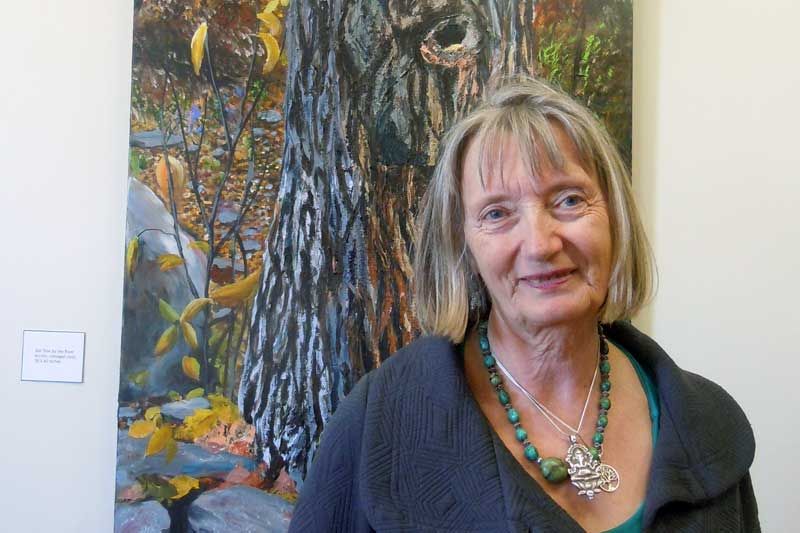Apr 15, 2015
Painting trees is one way that artist Gwen Frankton believes she can actively take on stand on the environment and conservation, and judging by the turnout at her new show at the MERA school house, she is definitely succeeding in bringing that conversation forward. The show titled “Every Green Tree”, on display until April 28, puts trees front and centre and for those adverse to the term “tree huggers”, her paintings go a long way in making their case.
Frankton, who calls both Ottawa and Maitland, Nova Scotia home, has been painting ever since she acquired a BFA at the University of Windsor decades ago. Now retired and a full time artist, it is her love of nature and particularly trees that inspired this show, which she chose to hold at MERA, a first for her, because as she said, “It just felt like the right kind of place to display this type of work”.
Her mostly acrylic works are lush and vibrant depictions of what she sees when venturing out in the woods of both Nova Scotia and eastern Ontario. The strength of these works is their freshness and frank honesty and the artist's refusal to follow any prescribed formula. She fittingly refers to each of these works as a “portrait”. With a botanist for a father, her childhood was filled with nature and botany so it is no wonder that this kind of subject matter, in her own words “really speaks to me.” Each of her trees is captured as she finds it in the real world, depicted in its own unique and intimate space, in various shapes and forms, and in differing states of light and shade, which gives each painting its own unique composition, color and style. “I think of how I paint trees as portraiture and I treat each tree as an individual entity like you would a person,” she said when we spoke at her vernissage, which took place at MERA on April 12.
One large work titled “Ash Tree by The River”, focuses on one tree that bears a thick, rough, undulating bark surface, which Frankton captured by applying thick, three-dimensional layers of paint that rise from the canvas and invite the viewer's caress. Up close the work is an abstract collection of large swaths of color: blues, purples and mauves on its shady sides; browns, pinks and tans on its front face, and it is unlike any other painting in the show.
Similarly, in “Birch 2, Nova Scotia”, a three trunked birch tree appears lusher than the birches from this area and Frankton explains that this is the case since this particular east coast birch grows near a water logged dyke. Unlike the ash tree, the trunks of this tree are velvety smooth, their finely blended colors slowly transitioning one to the next and with imposing splotches of lichen greens showing the lushness of this tree's wetter surrounds. This work demonstrates Frankton's new tendency to look at trees “particularly where they meet the ground, which is something that has really started to interest me.”
One series of four long thin works titled "Trees 1 through 4" focuses on four different trees at their mid-trunk and each is again a careful and unique color study. Some have a purple-blue glow and others are painted in brighter daylight and boast lively blotches of reds, purples and oranges that define each tree's special and very individual birth marks.
For those who tend to take trees for granted, Frankton's works offer viewers a chance to reconsider that position, and will likely turn those who have yet to really see trees in all their glory into ardent huggers. For more information visit www.gwenfrankton.com.
More Stories
- Latest CUPW Job Action Stops Postal Delivery Of The Frontenac News Forcing Alternate Plans
- Opponents of Barbers Lake Gravel Pit Pack Ag Hall in McDonalds Corners
- Bobsleigh Olympian Jay Dearborn At Mikes Pizza In Sydenham
- The Loins Club Of and O'Lakes Roar
- North Frontenac Back Roads Studio Tour - September 27 and 28
- Sunday Market Vendors Give Back
- George Street Work As Town Hall Renovation Nears Completion
- One Way Street Plan Hits A Dead End - Central Frontenac Council, September 9
- Global Gardening
- No Winner Yet in Catch The Ace But Fundraising Target Met

